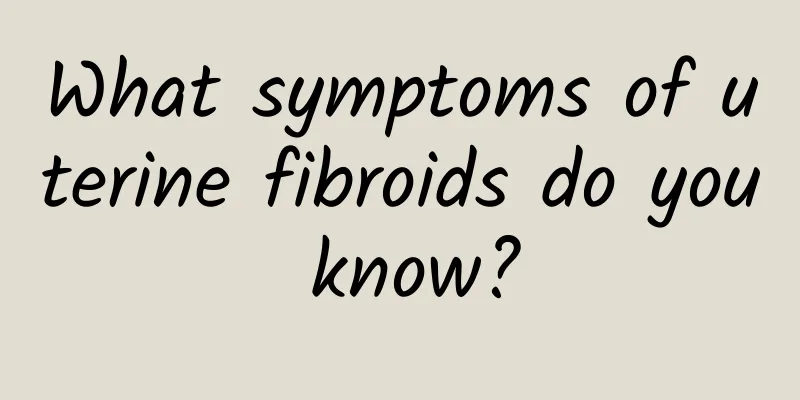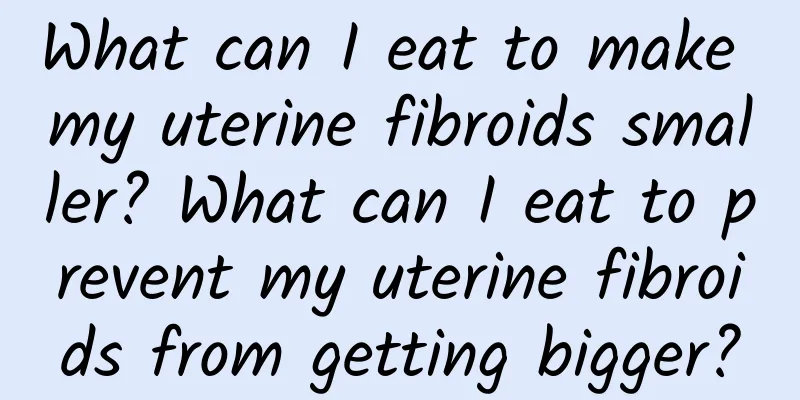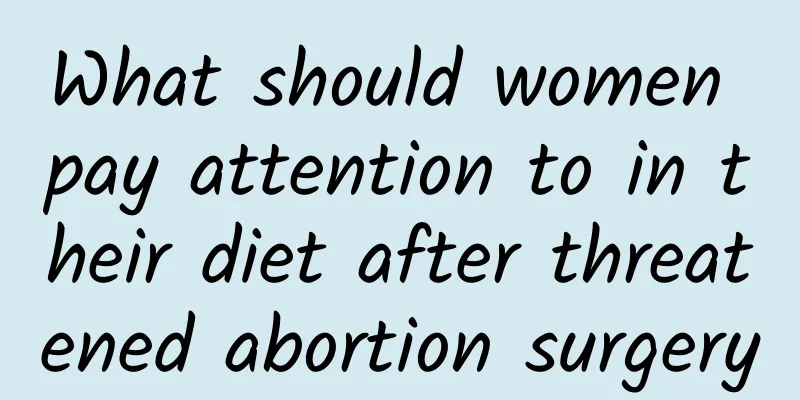What symptoms of uterine fibroids do you know?

|
What are the symptoms of uterine fibroids? What symptoms of uterine fibroids do you know? Uterine fibroids are the most common benign tumors of the female reproductive system. Uterine fibroids are very harmful to women, so what are the symptoms of uterine fibroids? In response to this question, we asked the experts to give us a detailed introduction to the symptoms of uterine fibroids, hoping to help you. Symptoms of uterine fibroids include: Abdominal mass: This is one of the symptoms of uterine fibroids. Patients feel the abdominal mass themselves, mostly after the uterine fibroids grow out of the pelvic cavity, and it is often obvious in the early morning when the bladder is full on an empty stomach. Because the uterus and fibroids are pushed upward, it is easy for patients to touch them themselves. If the uterus is larger than 4 to 5 months of pregnancy, it can also be touched when the bladder is not full. Uterine fibroids are generally located in the middle of the lower abdomen, and a few may be located on one side of the lower abdomen. They are hard or have an uneven feeling. Larger ones are more likely to be degenerated, softer and smoother. Most grow slowly. A very small number may grow faster or be accompanied by dull pain, and malignant changes should be suspected. Uterine bleeding: This is an obvious symptom of uterine fibroids, which occurs in half or more of the patients. It is mostly manifested as excessive menstrual flow, prolonged menstruation or shortened menstrual cycle, accounting for about 2/3; continuous or irregular bleeding accounts for 1/3. Bleeding is mainly caused by intramural fibroids and submucosal fibroids. Intramural fibroids often have periodic bleeding, while submucosal fibroids often show irregular bleeding. Subserosal fibroids rarely cause uterine bleeding, and in some cases, the menstrual flow is reduced. Compression symptoms: This is also a symptom of uterine fibroids, which often occurs in uterine cervical fibroids, or is caused by the enlargement of fibroids in the lower part of the uterine body, filling the pelvic cavity, and compressing the surrounding organs. Compression of the bladder can cause frequent urination or dysuria, urinary retention, etc.; compression of the ureter can cause hydronephrosis and pyelitis. Fibroids growing on the posterior wall of the uterus can compress the rectum, causing constipation and even difficulty in defecation. Compression of the pelvic veins can cause lower limb edema. Compression symptoms are more obvious in the early stage of menstruation, which is due to the congestion and swelling of uterine fibroids. If subserosal fibroids are incarcerated in the uterine rectal fossa, bladder or rectal compression symptoms may also occur. Pain: Pain is caused by the tumor compressing the pelvic blood vessels, causing blood stasis, or compressing the nerves, or the pedicled submucosal fibroids can stimulate uterine contraction, which is discharged from the uterine cavity to the outside, causing the cervical canal to widen and cause pain; or the necrosis and infection of the fibroids cause pelvic inflammatory disease, adhesions, traction, etc. If some people have red degeneration of uterine fibroids, the abdominal pain will be more severe and accompanied by fever. Acute and severe abdominal pain will also occur when the pedicle of the uterine subserosal fibroids is twisted or the uterus is axially twisted. Large subserosal fibroids grow into the broad ligament, which can not only compress the nerves and blood vessels to cause pain, but also compress the ureters to cause ureteral or renal hydrops and cause low back pain. Those with severe and progressive dysmenorrhea are often caused by uterine fibroids complicated by adenomyosis or endometriosis, which are symptoms of uterine fibroids. What are the symptoms of uterine fibroids? The above is a detailed introduction of the symptoms of uterine fibroids by experts, I hope it can help you. If you have more questions, you can click on our related website for consultation. Finally, I wish you good health. Uterine fibroids http://www..com.cn/fuke/zgjl/ |
<<: Do you know how to treat ovarian cysts?
>>: What methods do you know about uterine fibroids?
Recommend
Why does vulvar leukoplakia cause vulvar atrophy?
People think that the name of vulvar leukoplakia ...
How to treat pregnancy complicated with uterine fibroids? What are the treatments for pregnancy complicated with uterine fibroids?
The situations of patients with uterine fibroids ...
Is it useful to take medicine for threatened abortion?
Everyone has a different physique, and so do preg...
How can women prevent pelvic inflammatory disease?
Prevention of pelvic inflammatory disease has bec...
Can color Doppler ultrasound detect ectopic pregnancy? Vaginal color Doppler ultrasound is more accurate
Ectopic pregnancy is something every pregnant wom...
Can cervical warts be cured with medication?
When it comes to folk remedies, people always put...
What are the symptoms of chronic cervicitis in women? 4 symptoms of chronic cervicitis in women
There are many diseases that threaten women's...
How to treat irregular menstruation better? There are 3 ways to treat irregular menstruation.
How to treat irregular menstruation? 1. Psycholog...
What are the symptoms of mild cervical erosion? Three symptoms need to be vigilant
Cervical health needs to be taken seriously. Afte...
What are the symptoms of pelvic inflammatory disease? Timely treatment is needed
Women need to seek timely treatment after they de...
What does a uterine fibroid look like? What is inside a uterine fibroid?
Uterine fibroids are common benign tumors in wome...
What to do with irregular menstruation?
What should we do for irregular menstruation? It ...
Is pelvic effusion menstrual abnormality?
Pelvic effusion has many harmful effects. To bett...
Can I get pregnant if I have cervical erosion 3rd degree?
In recent years, the incidence of many gynecologi...
Why is menstruation irregular after abortion?
Why is there irregular menstruation after abortio...









